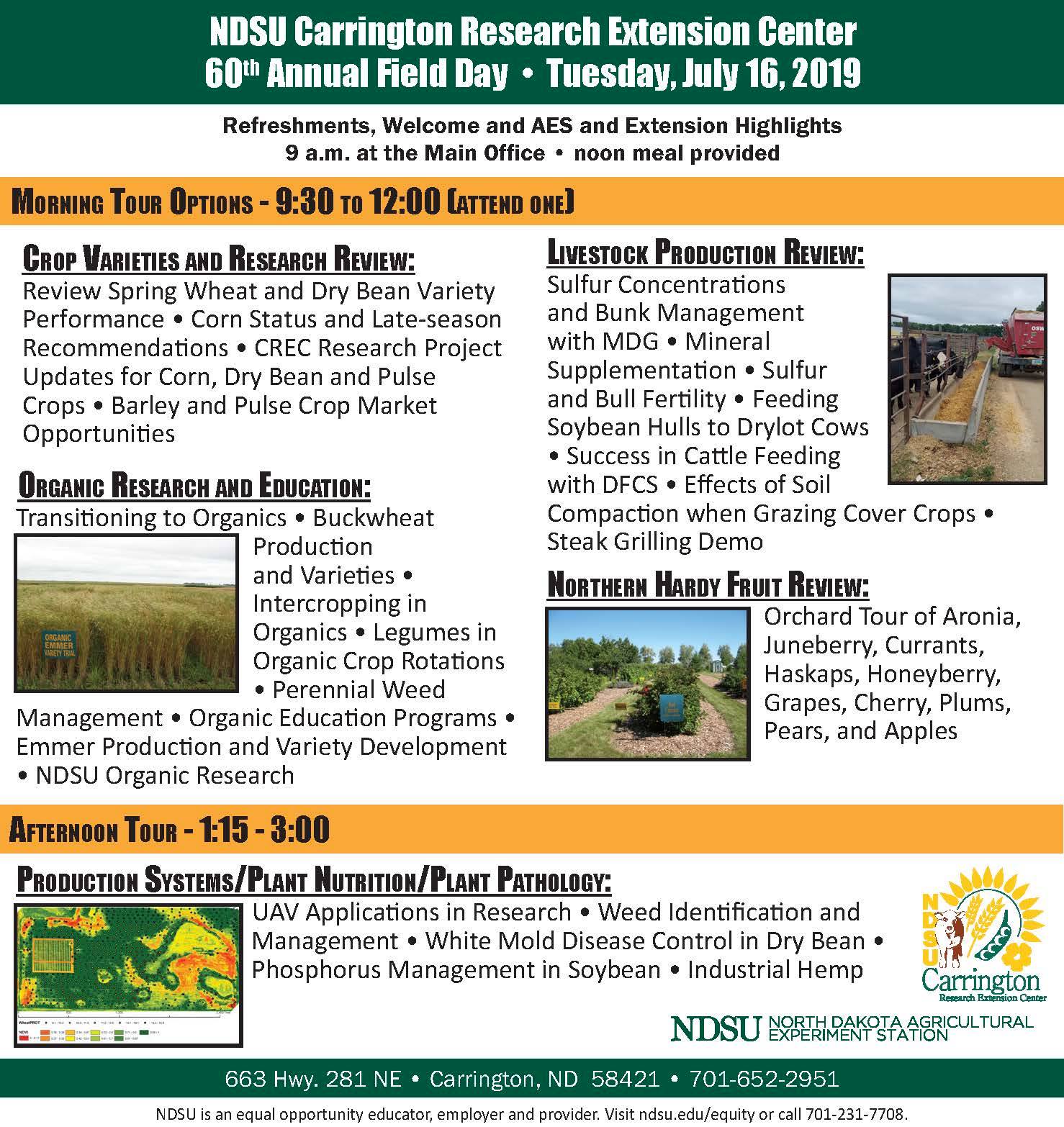2019
Row Crop Tour Set for Aug. 29
Farmers, crop advisers and agricultural industry representatives are invited to view field research trials and receive production recommendations on corn, soybeans and dry edible beans at the annual row crop field tour on Thursday, Aug. 29, at North Dakota State University’s Carrington Research Extension Center. Registration (with refreshments) will start at 4 p.m. and include exhibits of palmer amaranth and other pigweed species.
Questions that will be answered during the tour include:
- Will our corn crop reach maturity before frost and are there late-season management strategies to help preserve grain yield?
- What can we do now to aid in selecting the best soybean varieties to grow in 2020?
- When is the best time to terminate rye when grown as a cover crop with pinto bean?
- What fall-seeded cover crops are safe to grow after previously applied soybean herbicides that have soil residual?
- Is spray droplet size or sprayer boom height important determinants of the effectiveness of foliar fungicides against white mold in dry beans and soybeans?
- Is it possible to increase forage quantity or quality if additional crops are grown with corn?
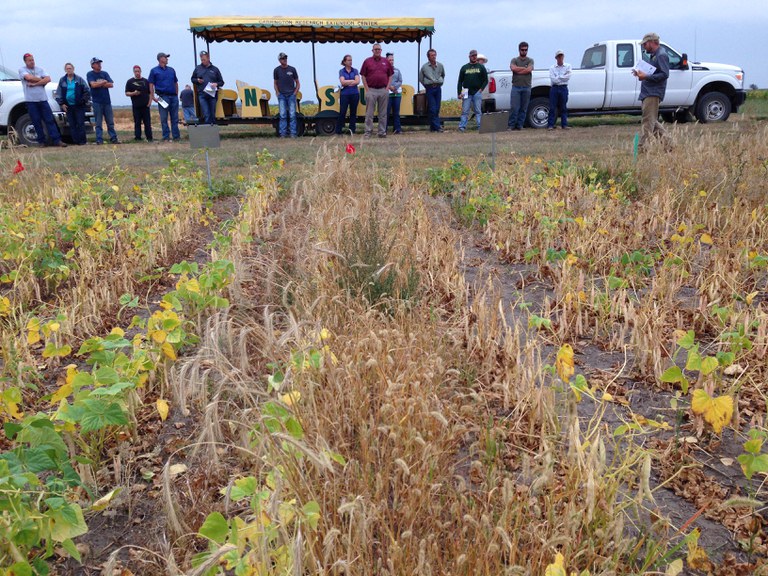
The tour will begin promptly at 4:30 and will include the following topics:
- Late-season corn and soybean plant development and management
- Soybean variety selection tips
- Research update on cover crops for soybeans and dry beans, with emphasis on winter rye
- White mold management in soybeans: Impact of soybean plant susceptibility and maturity; and spray droplet size, sprayer boom height, and application methods for fungicide efficacy
- White mold management in dry beans: Impact of fungicide spray droplet size, and row spacing and seeding rate
- Multi-cropping with corn
Tour speakers include NDSU Extension and North Dakota Agricultural Experiment Station agronomists Hans Kandel, Joel Ransom, Greg Endres and Mike Ostlie; and Michael Wunsch, plant pathologist.
A supper will follow the tour sponsored by North Dakota commodity organizations: ND Corn Utilization Council, ND Soybean Council and Northarvest Bean Growers Association.
Continuing education credits in crop and pest management will be available for certified crop advisers participating in the event.
For more information about the tour, call the Carrington center at 701-652-2951 or visit its website at https://www.ag.ndsu.edu/CarringtonREC.
Greg Endres
Gregory.Endres@ndsu.edu
Extension Specialist/ Agronomy
Spreader Pattern
The 2019 North America Manure Expo has ended. Last week while I was in Indiana, the landscape in North Dakota changed colors. As I flew home on Friday, what was solid green when I left is now green and golden with yellow sunflower heads adding accent. The color change not only means harvest, but also that it’s almost time for fall manure spreading in our state. Information about manure spreader calibration and the importance of it can be found here: https://www.ag.ndsu.edu/publications/livestock/manure-spreader-calibration-for-nutrient-management-planning.
Today, I want to discuss one thing we learn and see each year at Manure Expo: spreader pattern. Spreader pattern describes the pattern in which manure leaves the spreader and is applied across the field. Uneven, inconsistent spreader patterns result in uneven, inconsistent fertilizer placement. So, what can potentially cause an uneven, inconsistent spreader pattern?
- The first thing to check is the beaters. Whether they’re vertical or horizontal, twine and net wrap will wrap around them. Clearing debris from your beaters helps the equipment work at full potential.
- If the beaters are clean, the next thing to check is the floor chains. Is everything working in unison? Is something broken? If the manure is not being evenly moved to the beaters an uneven spreader pattern will result.
- Finally, how is the manure being loaded into the spreader? If one scoop is bedded pack and the next scoop is bunk scrapings you are likely going to cause an inconsistent spreader pattern because the products are very different in surface area.
If you run into inconsistent spreader patterns this fall while applying manure, remember to consider the simple issues listed above. The North Dakota Custom Manure Haulers List as well as manure testing labs can be found here: https://www.ag.ndsu.edu/lem/resources.
Happy hauling!
Mary Keena
Mary.Keena@ndsu.edu
Extension Specialist, Livestock Environmental Management
Rain and Hay Making Don't Mix
The past few weeks have been difficult for baling hay. A few days of decent hay cutting weather has been followed by rain. And then some more rain. Seasoned hay professionals know ‘rained on’ hay has reduced yield and poorer feed value than hay with no rain. But how much is yield and quality reduced?
The following text is from an article by Mike Rankin and Dan Undersander, University of Wisconsin ‘Rain Damage to Forage During Hay and Silage Making’. The full piece can be found here: https://fyi.extension.wisc.edu/forage/rain-damage-to-forage-during-hay-and-silage-making/.
Rain that occurs between the time forage is cut and harvested causes both yield and quality losses that reduce the value of the crop as an animal feed and a marketable commodity. Weather-induced losses can be caused by:
- Increased and prolonged plant respiration that reduces soluble carbohydrates and the overall energy content of forage.
- Leaching of soluble carbohydrates, protein, and certain minerals.
- Leaf shattering and loss, removing the highly digestible and high protein portion of the forage.
- Microbial activity that metabolizes soluble carbohydrates, reduces forage energy content, and possibly produces harmful mycotoxins.
- Color bleaching.
How much does rainfall reduce yield?
Several research studies have addressed the effects of rainfall on cut alfalfa. In Wisconsin, Collins measured dry matter losses of 22% when alfalfa was exposed to 1-inch of rain after 1 day of curing. Similar hay cured without rain damage lost only 6.3% of the initial potential yield. Losses appear to be greatest after partial drying of the forage has occurred. In this same study, alfalfa exposed to 1.6 inches of rain over several days suffered a 44% loss in dry matter.
How does rainfall reduce yield?
Three primary factors are involved: leaching, respiration, and leaf loss.
- Leaching is the movement of cell solubles out of the plant. Components of the plant that are very water-soluble are leached out of the forage and lost during a rain event. Unfortunately, most of these compounds are those highly digested by the animal. They include such things as readily available carbohydrates and soluble nitrogen, minerals, and lipids. About one-half of the dry matter leached by rain is soluble carbohydrate. Excessive leaching of soluble carbohydrates by rainfall impacts its value to make good silage. Reduced soluble carbohydrates provide less substrate for bacteria involved in the fermentation process. In situations where soluble carbohydrates are in low concentrations, silage additives that provide fermentable substrate might provide some benefit to ensure proper fermentation.
- Respiration, the breakdown of soluble carbohydrates by plant enzymes, will cause dry matter losses regardless of whether wilted forage is subjected to rain or not. Respiration losses occur while crop moisture levels are above about 30 percent. These losses are reported to be about 3 to 4 percent of the potential DM harvest. Each time cut forages are wetted by rain, respiration is prolonged or begins again in cases where the cured forage is already below 30 percent moisture. In either situation, additional dry matter is lost.
- Experience and common sense tell us that rain damaged alfalfa is more susceptible to leaf shatter after it dries. Rainfall often means additional raking or tedding to speed up drying; hence, more lost leaves.
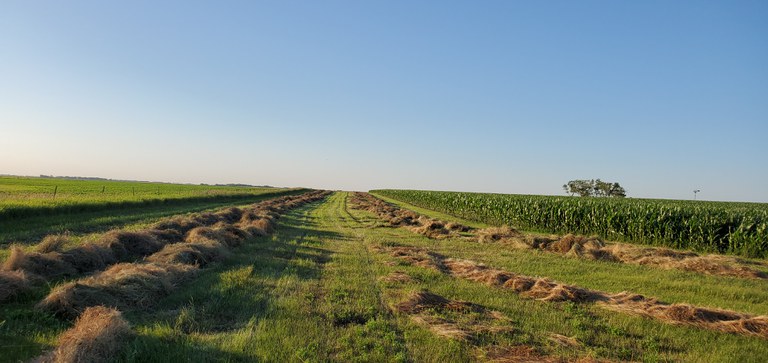
Windrows of drying hay, July 2019.
How does rainfall intensity and forage moisture affect losses?
Research is conclusive on these two points. Given the same amount of total rainfall, a low intensity rain will result in more leaching of soluble compounds than a high intensity rain. In addition, as forage moisture declines, it is more prone to DM loss from rain. In Wisconsin rainfall studies, the maximum loss in DM (54% DM loss) was a treatment where 2.5 inches of rain fell on hay that was nearly cured.
Does rainfall affect forage quality?
Perhaps nothing is more frustrating than to see excellent quality alfalfa turn into cordwood with each passing rainstorm and subsequent raking. Most rainfall studies agree that wetting of field cured alfalfa has little impact on crude protein concentration. In fact, it is common to see relatively high protein values in comparison to fiber concentrations. However, because rain leaches soluble carbohydrates, structural fibers (acid and neutral detergent fibers) comprise a greater percent of the forage dry matter. Depending on numerous factors previously discussed, the digestibility of rained-on hay may decline from 6 to 40 percent.
“Make hay while the sun shines” is an old adage that still rings true today. Watch the weather forecast and hope for better weather; or consider making haylage.
Karl Hoppe, Ph. D.
Karl.Hoppe@ndsu.edu
Livestock Extension Specialist
Potassium Deficiencies in the Corn Fields: Are There Late Remedies?
Until recently, potassium (K) deficiencies had been less prevalent for most ND farming areas; corn response to K fertilization has predictably been low because of adequate K availability (usually >150 ppm soil test) versus zones that because of their clay chemistry, are predicted to be more responsive to K (with critical level > 200 ppm https://www.ag.ndsu.edu/publications/crops/north-dakota-clay-mineralogy-impacts-crop-potassium-nutrition-and-tillage-systems).
What is happening this year that is causing areas of fields that have rarely before shown K deficiency for corn to now seemingly be low in available K?
It is not uncommon for soil K test levels to vary within fields; thus there may be some K deficient areas within a field whose average soil K test level was adequate. In the future, sampling by zone within a field will help to identify areas of particular K need.
Potassium deficiency symptoms will show up when K is low, for prolonged wet soils, dry soils, and in shallow topsoil. When drought occurs (low availability of soil moisture) in the topsoil when corn has attained V6 to about knee high (Fig 1), and demand for K starts increasing rapidly, is a period where K deficiency is most likely to appear. The crop is likely to begin losing its yield potential.
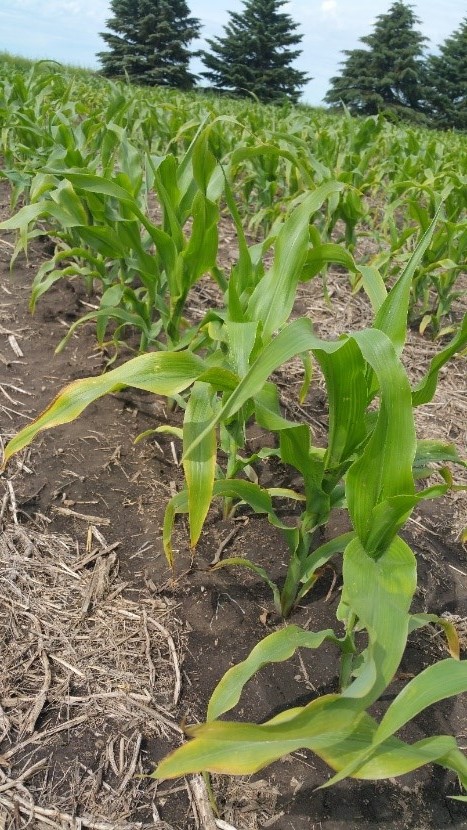
Figure 1. Close-up of K deficient corn. Note the lower leaves are most affected with yellowing on leaf margins with mid-rib remaining green the longest.
Symptoms are first seen on older (lower) leaves, where K first gets depleted as it is transported to younger leaves, showing yellow coloration and browning (drying) of leaf margins. In severe cases, younger leaves will show symptoms as well, and plants are evidently stunted.
Is there a remedy for K deficiency after symptoms are detected?
The crop often regains its green appearance with the development of new leaves, as conditions for K availability eventually improve with improved accessibility to K from fertilizer application, more developed roots, or improved soil moisture. However, corrective attempts by broadcasting (potash) or dribbling K (thiosulfate) will help regain most of the yield potential.
The recommended rate is 100 lbs of potash, 0-0-60 (60 pounds K2O per acre).
It is important to soil sample and analyze K for affected and non-affected areas to help determine the future course of action, whether to adjust future K fertilization rates, and if necessary, the method of application. Ear leaf sampling at the onset of silking is also suggested to verify if K content is within the sufficiency range used by the state soil testing lab.
Potassium deficiency in corn was also recently addressed, in brief, in the July 11 North Dakota State University Crop and Pest Report: https://www.ag.ndsu.edu/cpr/soils/potassium-deficiency-in-season-diagnosis-and-correction-in-corn-07-11-19.
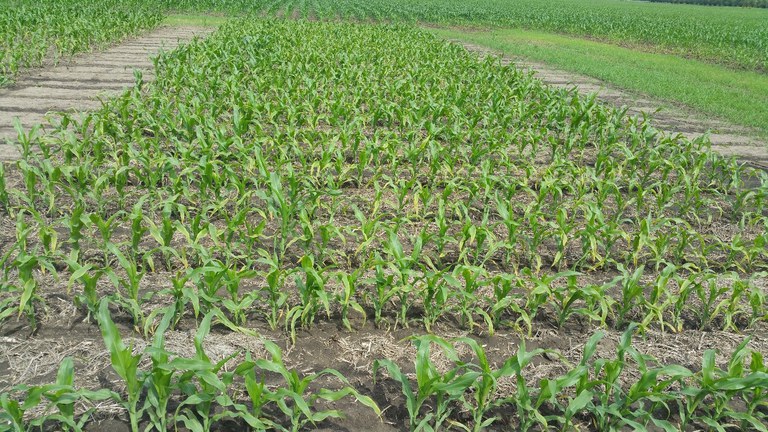
Figure 2. Shortage of rainfall is likely a cause for low K availability. A dry spell during which rainfall was over 40% below normal for about 7 days before 1 inch of rainfall at the Carrington Research Extension Center.
Jasper M. Teboh, Ph.D.
Research Soil Scientist
Jasper.Teboh@ndsu.edu
We Get By, With (a lot of) Help
During the summer, we double our staff by hiring high school and college students, grad students and interns. This week, we want to thank our summer crew for some of the things they do:
- Packaging seed and fertilizer for trials. The experienced and proven ride planters, pouring seed and fertilizer into our plot-scale equipment as trials are established.
- Stand counts. We know how many seeds we planted, but how many sprouted and developed into a plant? And thinning to achieve a specific plant population in each replication of a trial.
- Hand-weeding. Sometimes for esthetics, but mostly per protocol.

Some of the summer crew hand-weeding in the plots.
- Collecting samples like soil, roots, leaves, stems, and seed. One team has exclusively been digging, washing and evaluating lentils and peas for root rot in our root disease management studies.
- A team has been constructing micro-irrigation sprinkler systems in our pathology studies (we’ll have approximately 40 acres of mist systems this year).
- Our most-experienced summer crew are or were agronomy students at NDSU (Go Bison!) and possess certifications that allow them to apply pesticide treatments. Our veterans also have the knowledge base required to take field notes -- recording plant maturity, height, and disease level; and measuring plant health with GreenSeeker infrared light meters.
- One of our interns flies UAV drones, collecting thousands of images per flight, and programs software to stitch those images into field maps.
- An Integrated Pest Management crop scout surveys for disease and insect pests on wheat, barley, sunflower, and soybean. GPS coordinates are recorded with pest data, and maps are posted online for producers and crop consultants.
- Specific varieties of berries are replicated in our orchard, and yields and quality are measured per trial. Each bush must be picked separately and consistently.
- We replicate livestock trials and follow care and feeding protocols for each pen. Extra summer help fixes fence, mows yards, and bales hay and straw. Moving and weighing cattle go better with additional help, too.
- Yard work ranges from trimming trees to weed eating and includes at least one round of cleaning gutters every summer.
- Ever heard, “if you’ve got time to lean, you’ve got time to clean”? (Insert eye-roll here.) With more than 70 people, over two dozen buildings, and a fleet of vehicles and farm equipment, there is always a floor to sweep or vacuum, a car to wash, trash to collect, and windows to clean.

Digging for roots.
Our 60th Annual Field Day is Tuesday, July 16. Our summer crew will be very visible, as usual, greeting every vehicle that arrives, directing guests to parking and seating, and handing out programs. They will have set up every table and chair, will be escorting guests as needed, will haul trash during the day, and will clean everything as it’s put away.
Along with contributing a lot of hard work, our summer crew keeps us young and thinking of fresh ways to approach life. It’s a sure sign of spring when the early birds of our summer crew stop in to start their hiring paperwork, and it’s a sad day when the last of the crew leaves - another reminder of how short our North Dakota summers are.
Thanks, Summer Crew, for everything you do. We appreciate you.
CREC Staff
NDSU.Carrington.REC1@ndsu.edu
60 Years of Tradition
The Carrington Research Extension Center will be hosting our Annual Field Day on Tuesday, July 16, 2019. Field Day kicks off at 9 a.m. with a welcome and refreshments at the Main Station. Morning tours leave the yard at 9:30.
There are four tours to choose from in the morning:
- Crop Varieties and Research Review
- Livestock Production Review
- Organic Research and Education
- Northern Hardy Fruit Review.
After a noon meal, there will be an additional agronomy tour from 1:15-3:00 p.m. on the topics of Production Systems/Plant Nutrition/Plant Pathology.
This Field Day is special to us because we are celebrating 60 years of showing farmers, ranchers and other agricultural constituents examples of our research projects and sharing information they may use in managing their agriculture operations. Throughout these 60 years, the scope of research projects and information shared during the field day has grown and evolved. In the early 60’s, the trials were exclusive to the subject of irrigation whereas this year’s field day has the diversity of programs previously mentioned.
Field Day is free and open to the public. We hope you will join us on July 16.
If you choose to visit us at any other time of the year, know you are certainly welcome. If you do visit, please check in at the Main Office so that someone may direct you to your areas of interest and to provide guidance or direction to ensure your safety and the integrity of ongoing research projects.
Please call us with questions at 701-652-2951.
Blaine Schatz
Blaine.Schatz@ndsu.edu
Director and Agronomist
CRS Team
The programs at the Carrington Research Extension Center (CREC) would not survive without a good team. To be a good team, members should always think safety first, have a positive mind set, exhibit good work ethic and share the same goals for a productive program. These attributes lead to a functional, productive team. This is the case with the CREC Foundation Seedstocks team, which produce high quality test results/seed lots for our multi-state agricultural constituents.
Chad Richter, our newest seedstock member, is now in his sixth year. His farming background helps our program immensely. He has a wide range of duties including tillage, planting, spraying, equipment maintenance and repair, customer seed load-out, combining and seed conditioning. I would also like to mention that Chad has been a volunteer fireman for many years!
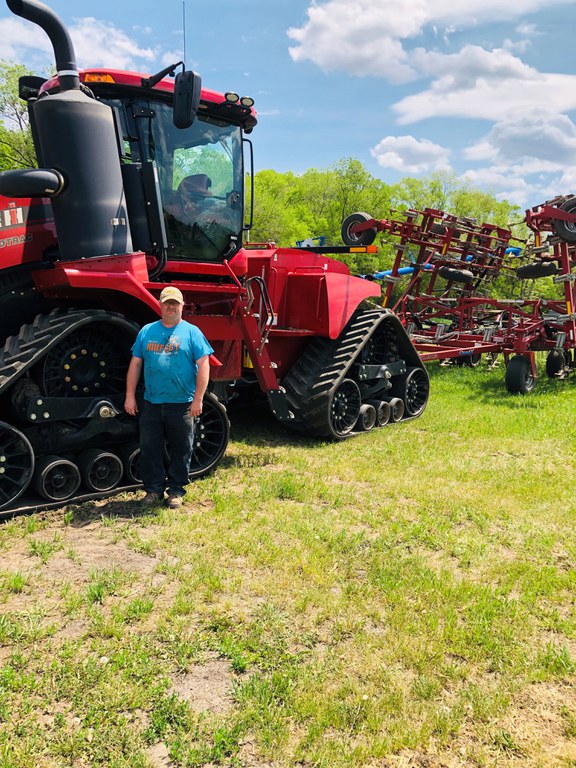
Chad Richter
Rick Richter is our seedstock team’s ‘Mr. Reliable’. After 19 years, he is our go-to person. He started working at the CREC as a livestock technician. After a few years, he started splitting his work time between livestock and seedstocks. Rick’s vast knowledge and background in farming works well within our team. He, like Chad, wears many hats on our team. Rick is my main contact in the field when I can’t be out there. Whether he is working on field preparation, planting, spraying, harvesting, working on maintenance or field scouting he is always productive and seldom found around the yard. Rick is currently serving as a city councilman for Sykeston.
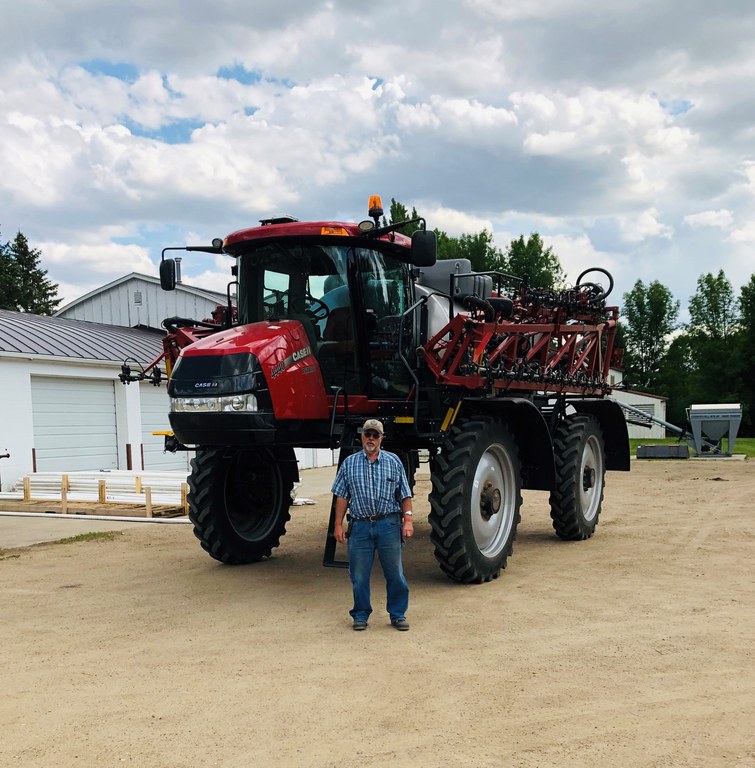
Rick Richter
Scott Fetch is the seedstock team’s ‘Mr. Fix-it’ and maintenance person. Now in his 16th year, Scott is our go-to person for repairs and often has his day interrupted by a breakdown. He is very good at getting the equipment fixed as soon as possible to keep us running. When he’s not fixing equipment, Scott can be seen planting, spraying, irrigating, combining or baling. Scott, who has been a volunteer on many boards, is currently serving as president of the Carrington School Board.
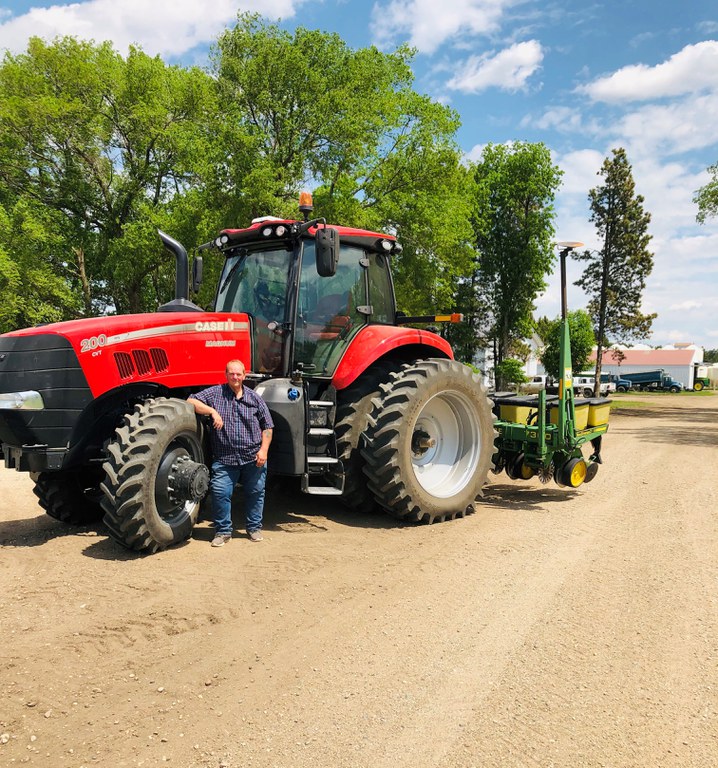
Scott Fetch
This blog post is written to show my appreciation toward the CREC Foundation Seedstock’s team. The team members are Chad, Rick and Scott and they are the CRS Team. Their years of experience and ability to be flexible help keep our program effective and efficient. So, thank you, team, for all your hard work and dedication to the program!
Dave Copenhaver
David.Copenhaver@ndsu.edu
Seedstocks Research Specialist
Breeding Season at the Carrington REC
Just like many beef producers in North Dakota, this week represents the start of breeding season here at the Carrington REC. Over the past week, the livestock crew has been working to synchronize the cow herd in preparation for artificial insemination (AI). Artificial insemination provides producers an opportunity to use sires with superior genetics at lower cost than purchasing a herd bull with similar genetics. Using AI at the CREC also offers an opportunity to collaborate with on-campus researchers, researchers from other universities, and industry partners to find solutions to improve conception rates to AI.

Cierrah Kassetas, NDSU Animal Science graduate student, breeding a cow using artificial insemination (AI).
The following link provides some information for those producers considering using AI and is a good refresher on ways to maximize pregnancy rates for those of us already using AI: https://www.ag.ndsu.edu/pubs/ansci/livestoc/as1749.pdf
I hope you all have a good, safe, productive summer.
Bryan Neville, Ph. D.
Bryan.Neville@ndsu.edu
Animal Scientist
Hemp
Starting in 2019, the CREC is conducting hemp research. Hemp is a new crop option with some already established markets. Specifically, the seed is harvested and crushed for oil that is used in a wide array of products. Other countries, including Canada, have had hempseed production for some time already and we base our management strategies on what they have learned. With the recent farm bill, hemp production has had several hurdles removed making it easier to grow commercially and for research. Trials at the CREC include variety screening, seed treatments and herbicide tolerance testing. This year we are evaluating 12 cultivars representing a good diversity of material, and there are already some differences showing up in emergence (Figure 1).
 Figure 1. Emergence of hemp varieties 2 weeks after planting. This trial was seeded in 14” rows.
Figure 1. Emergence of hemp varieties 2 weeks after planting. This trial was seeded in 14” rows.
Because it is a new crop, there are many production and marketing questions. We will be providing a quick overview of hemp production at our 60th Annual Field Days on July 16th. We are also having a more focused event on hemp production, marketing, and economics on July 24th at the CREC. Stay tuned for more details about these two events. While there are other uses for hemp including fiber and CBD oil, these events will largely focus on hempseed production.
Mike Ostlie
Mike.Ostlie@ndsu.edu
Research Agronomist
Crop Management Field School 2019
North Dakota State University Extension’s annual Crop Management Field School will be Wednesday, June 19, starting at 9 a.m. at the Carrington Research Extension Center (CREC).
The school will provide updates on crop, pest and soil management recommendations using hands-on training in field demonstration plots and research trials.
The program is designed for crop advisers, but also will be beneficial for farmers.
Field sessions include:
- Weed identification - identify about 60 living weed exhibits, plus receive brief reviews on selected weed biology and control
- Herbicide site-of-action - identify herbicide classes by examining crop and weed injury symptoms
- Late-season small grain disease management - review crop stages and disease identification, plus most effective use of fungicides to protect wheat seed yield and quality
- Improving soil productivity - dig in the soil and have audience interaction to learn about soil health
- Weed management - view selected research trials to discuss weed control issues
School instructors include NDSU crop specialists and researchers Greg Endres, Andrew Friskop, Joe Ikley, Lesley Lubenow, Mike Ostlie and Abbey Wick.
Preregistration is required, and 50 participants will be accepted on a first-come, first-served basis. Participants will receive reference materials, refreshments and a noon meal. Certified crop advisers will receive five continuing education units in crop pest, and soil and water management.
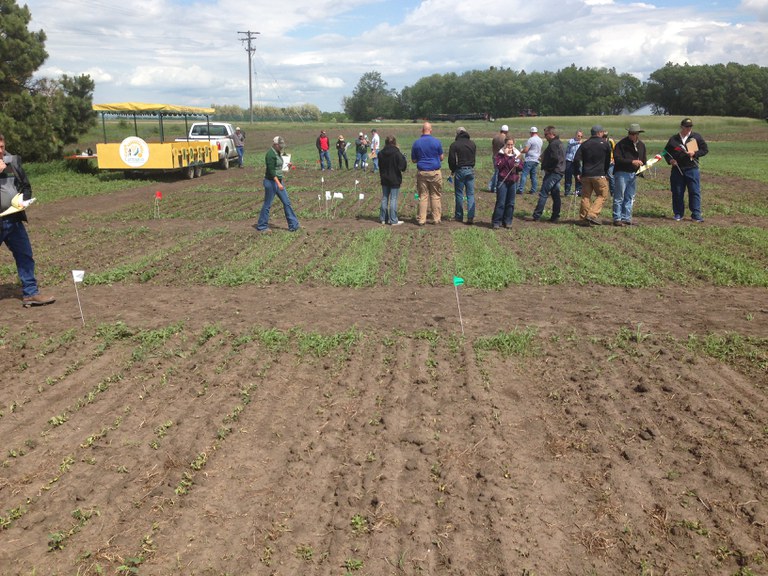
For more details and preregistration information, visit http://www.ag.ndsu.edu/CarringtonREC/ or contact the CREC at 701-652-2951. A completed preregistration form and $100 fee is required by June 14.
Greg Endres
Gregory.Endres@ndsu.edu
Extension Agronomist


